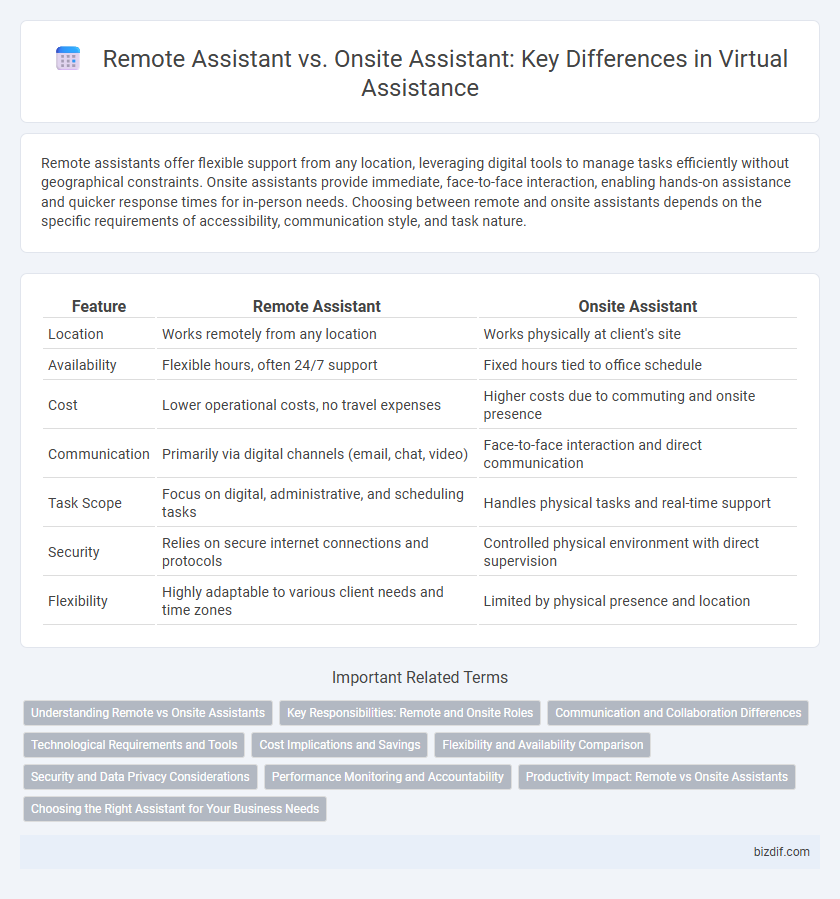Remote assistants offer flexible support from any location, leveraging digital tools to manage tasks efficiently without geographical constraints. Onsite assistants provide immediate, face-to-face interaction, enabling hands-on assistance and quicker response times for in-person needs. Choosing between remote and onsite assistants depends on the specific requirements of accessibility, communication style, and task nature.
Table of Comparison
| Feature | Remote Assistant | Onsite Assistant |
|---|---|---|
| Location | Works remotely from any location | Works physically at client's site |
| Availability | Flexible hours, often 24/7 support | Fixed hours tied to office schedule |
| Cost | Lower operational costs, no travel expenses | Higher costs due to commuting and onsite presence |
| Communication | Primarily via digital channels (email, chat, video) | Face-to-face interaction and direct communication |
| Task Scope | Focus on digital, administrative, and scheduling tasks | Handles physical tasks and real-time support |
| Security | Relies on secure internet connections and protocols | Controlled physical environment with direct supervision |
| Flexibility | Highly adaptable to various client needs and time zones | Limited by physical presence and location |
Understanding Remote vs Onsite Assistants
Remote assistants offer flexible support through digital communication platforms, allowing businesses to access skilled professionals without geographical limitations. Onsite assistants provide direct, in-person assistance that enables immediate interaction and hands-on support for tasks requiring physical presence. Understanding the differences in availability, communication style, and task suitability helps organizations choose the right assistant based on operational needs and efficiency goals.
Key Responsibilities: Remote and Onsite Roles
Remote assistants manage tasks such as email handling, scheduling, and virtual customer support, leveraging digital tools for communication and project management. Onsite assistants perform in-person duties including office management, event coordination, and direct client interaction, ensuring seamless daily operations. Both roles require strong organizational skills, but remote assistants prioritize virtual collaboration while onsite assistants focus on physical presence and immediate assistance.
Communication and Collaboration Differences
Remote assistants rely heavily on digital communication tools such as video calls, instant messaging, and cloud-based collaboration platforms to maintain seamless interaction and teamwork across different locations. Onsite assistants benefit from face-to-face communication, enabling quicker feedback, clearer non-verbal cues, and more spontaneous collaboration during tasks. The choice between remote and onsite assistants impacts the immediacy, clarity, and dynamics of communication and collaboration within the workplace.
Technological Requirements and Tools
Remote assistants rely on high-speed internet, cloud-based platforms, and collaboration tools like Zoom, Slack, and digital project management software to ensure seamless communication and task execution. Onsite assistants depend on physical access to office equipment, local network systems, and often use traditional tools like telephone systems, in-person communication, and office software installed on local machines. The technological infrastructure for remote assistants emphasizes connectivity and cybersecurity, while onsite assistants focus more on hardware integration and direct system access.
Cost Implications and Savings
Remote assistants typically reduce operational costs by eliminating expenses related to office space, utilities, and commuting, resulting in significant savings for businesses. Onsite assistants, while offering direct interaction and immediate availability, often incur higher costs including workspace allocation, equipment, and transportation reimbursements. Choosing remote assistance leverages technology to optimize budget efficiency without compromising task execution quality.
Flexibility and Availability Comparison
Remote assistants provide greater flexibility by offering 24/7 availability and support from any location, enabling businesses to access expertise beyond geographical constraints. Onsite assistants deliver immediate, face-to-face support but may be limited by fixed working hours and location. The choice between remote and onsite assistants depends on the need for continuous accessibility versus personalized, in-person interaction.
Security and Data Privacy Considerations
Remote assistants rely on encrypted communication channels and secure cloud storage to protect sensitive data, but they introduce risks related to unauthorized network access and data breaches if endpoints are compromised. Onsite assistants benefit from physical security controls and direct supervision, reducing vulnerability to external cyber threats, though they may face risks from insider threats and local data mishandling. Implementing robust access controls, regular security audits, and stringent data privacy policies is critical for both remote and onsite assistants to ensure compliance with regulations like GDPR and HIPAA.
Performance Monitoring and Accountability
Remote assistants use advanced performance monitoring tools such as screen recording, activity tracking, and real-time analytics to ensure productivity and accountability from any location. Onsite assistants are directly supervised, allowing immediate feedback and hands-on management, which can enhance accountability through physical presence. Combining digital monitoring with in-person oversight often results in higher performance standards and transparent accountability metrics.
Productivity Impact: Remote vs Onsite Assistants
Remote assistants enhance productivity by leveraging digital tools and flexible schedules, enabling seamless multitasking and immediate access to information from diverse locations. Onsite assistants benefit from direct interaction, fostering faster communication and real-time problem-solving that reduces delays. Productivity outcomes often depend on task complexity and the need for physical presence, with hybrid models optimizing efficiency by combining remote adaptability and onsite immediacy.
Choosing the Right Assistant for Your Business Needs
Remote assistants offer flexibility by handling tasks virtually, enabling businesses to save on office space and reduce overhead costs, ideal for companies with hybrid or fully remote teams. Onsite assistants provide direct, face-to-face support critical for tasks requiring physical presence, immediate collaboration, or access to on-location resources. Selecting the right assistant depends on your operational needs, budget constraints, and the nature of tasks--prioritize remote assistants for digital and administrative tasks, and onsite assistants for hands-on support and real-time problem solving.
Remote assistant vs Onsite assistant Infographic

 bizdif.com
bizdif.com